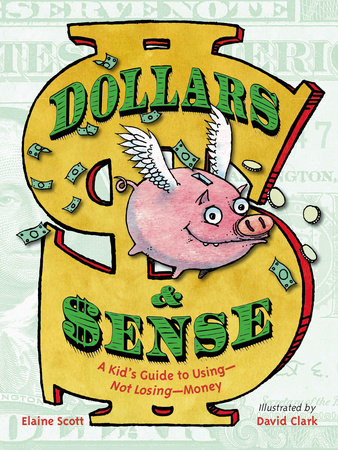We’re in the money!
Many things come with instructions. Unfortunately, money isn’t one of them. Most people learn how to use it—or lose it—by trial and error.
Dollars & Sense is a basic operating instruction manual for money that will teach readers about the history of money, the way our American economy works, and how to make important decisions about personal finance.
From skulls, sheep, and shells as barter in ancient civilizations to credit, interest, and collateral of our modern day economics, money—and all its glorious uses and cantankerous troubles—is explained in this concise and entertaining volume. Learn about how to make money, how to budget your money, how the government manages (or mismanages!) money, and how to be rich without even trying. Money is sometimes your friend and sometimes your enemy, but in this day and age, we all have to learn to get along with it.
An engaging and approachable guide for kids tackling how to responsibly manage their money.
Included are sidebars, time lines, diagrams, a glossary, and further resources, as well as information on related topics such as the Great Recession and sequestration.
Elaine Scott is the author of several books for young readers, including
Buried Alive!: How 33 Miners Survived 69 Days Deep Under the Chilean Desert;
Space, Stars, and the
Beginning of Time: What the Hubble Saw; and
When Is a Planet Not a Planet? The Story of Pluto (Clarion). Elaine lives in Houston, Texas.
David Clark is the illustrator of more than fifteen books for children, including
Fractions in Disguise by Edward Einhorn,
What's for Dinner? Quirky, Squirmy Poems from the Animal World by Katherine B. Hauth, and
Pirate Bob by Kathryn Lasky. He is also the illustrator and co-creator of the syndicated comic strip
Barney & Clyde. He lives in Luray, Virginia.
A sporty guide to the wide, weird world of money. Scott starts with the early forms of barter; when barter outgrew itself as the population increased: "things that were traded simply didn't match up evenly. There was no common medium of exchange." Those mediums came, in the form of salt, cowrie shells, wampum, feathers, and precious metals and gems. Buoyed by Clark's comic, explicative ink drawings, Scott sallies on to cover the evolution of currency and economy, mediums of exchange and standards, and charts the evolution of banks (" ‘Bank' comes from the Italian word banco, meaning a long bench on which money changers set up shop"). Numerous sidebars serve as attending footnotes to cover such topics as personalities, Hammurabi's Code, banking supervision, and the Dodd-Frank Act. It is too much to ask this brief introduction to get into the mechanics of banking, but some illustrative examples would have been heaven sent. For instance, what triggers inflation? That would have helped the latter discussions of recession and depression. But even at surface level, readers will follow the dominos and get a good grasp of debt. They will also take a long look at "The Government Steps In," and especially the Troubled Assets Relief Program, and likely ask, how has that alleviated the banking situation? An informative primer on how money functions that doesn't trigger the dismal science's snooze button.
-
Kirkus Reviews
"Unfortunately, money doesn't come with a set of instructions," writes Scott in her introduction to this practical guide to earning, spending, saving, and understanding the role that money plays in our society. Scott walks readers through economic concepts like supply and demand, banks and how they operate, debt, interest, inflation, and investing, all accompanied by Clark's cartoon caricatures of people and animals. One of eight chapters discusses the Great Depression and its aftermath, and another explores the 2007-2009 Great Recession ("There was simply too much debt in the economy, and it couldn't be repaid"). Day-to-day basics, such as the correct way to fill out a check, should help give solid footing to readers dealing with earning and spending for the first time.
- Publishers Weekly
At first glance, this title appears to be a guide to budgeting and spending money wisely, but upon closer inspection, readers will discover this work to be an overview of the history of money—from the exchange of goods and services to the current economic climate. The introduction includes famous quotes from the film Cabaret, the Bible, and Henry Ford as well as a brief overview of the Enron scandal, all in a snappy attempt to show how money is essential to life (even if it is often considered the root of all evil). Beginning with ancient methods of exchange, the text covers the evolution and current state of banking systems in the United States. Other chapters take a break from the history lesson to discuss corporations, stocks, loans, bank accounts, checks, and other types of accounts. A section on handling debt is not only thorough but also timely. Readers will find that the highlighted terms (defined contextually and in the glossary), such as recession, depression, stock, inflation, and foreclosure, clarify a complex system and give a better understanding of the economy on an everyday scale. A solid introduction to economics and the history of monetary systems.
- School Library Journal

















